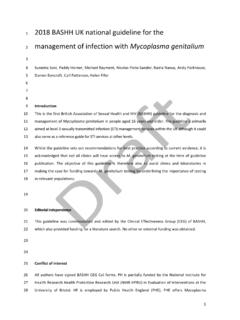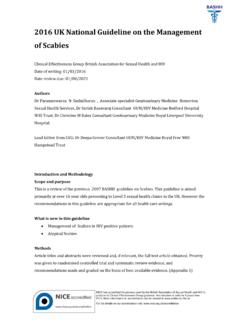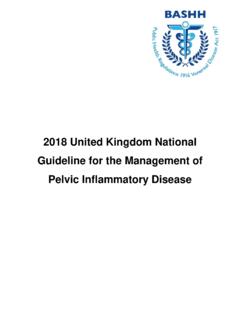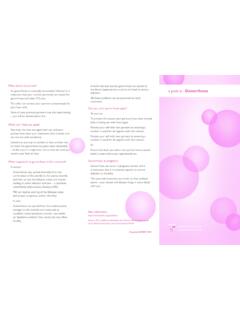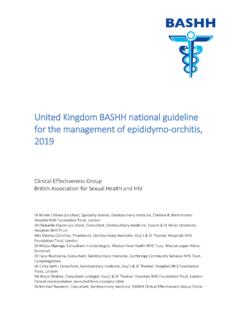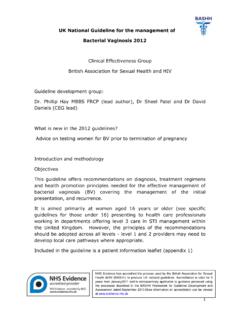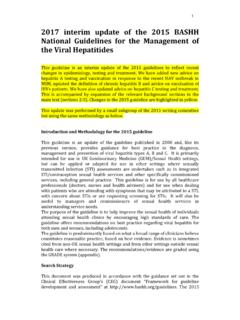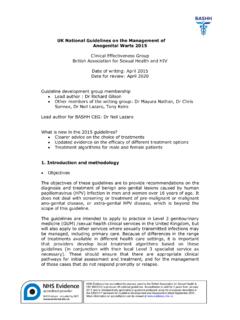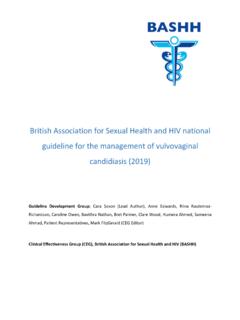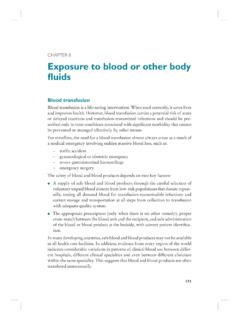Transcription of UK Guideline for the use of HIV Post-Exposure Prophylaxis …
1 UK Guideline for the use of HIV Post-Exposure Prophylaxis 2021 Corresponding author: Guideline writing group Kaveh Asanati Consultant Occupational Physician Honorary Clinical Senior Lecturer, National Heart & Lung Institute, Imperial College London Sanjay Bhagani Consultant Physician Royal Free Hospital, London Senior Lecturer, Institute for Global Health, University College London Marta Boffito Consultant Physician Chelsea and Westminster Hospital, London Reader, Imperial College London Fiona Cresswell (Chair) Specialist Registrar, Brighton and Sussex University Hospital, Brighton Clinical PhD Fellow, London School of Hygiene and Tropical Medicine Valerie Delpech Consultant Epidemiologist, Public Health England Jayne Ellis Specialist Registrar, Hospital for Tropical Diseases, University College London Hospitals NHS Foundation Trust, London, UK Julie Fox Consultant HIV Medicine and Clinical Trials, Guy s and St Thomas Hospital Honorary Reader Kings College London Linda Furness Sexual Health Adviser, Cardiff Royal Infirmary Nadi Gupta British HIV Association Guideline Committee Consultant HIV and Sexual Health, Rotherham NHS Foundation Trust Margaret Kingston British Association of Sexual Health and HIV Clinical Effectiveness Group Consultant Physician, Manchester Royal Infirmary.
2 Honorary Chair Manchester University Massoud Mansouri Consultant Occupational Physician Deputy Course Director in Occupational Health, School of Medicine, Cardiff University Amanda Samarawickrama Consultant HIV and Sexual Health, Sexual Health South West London Kat Smithson National AIDS Trust Alex Sparrowhawk Terrence Higgins Trust Keith Radcliffe Chair BASHH Clinical Effectiveness Group, Consultant HIV and Sexual Health Whittall Street Clinic, Birmingham Paul Rafferty Clinical Pharmacist, Belfast Health and Social Care Trust, Northern Ireland HIV Pharmacy Association representative Alison Rodger Professor of Infectious Diseases, Institute for Global Health, University College London Consultant in Infectious Diseases, Royal Free London NHS Foundation Trust Tom Roper Clinical Librarian, Brighton and Sussex University Hospitals NHS Trust Laura Waters British HIV Association Chair Consultant HIV and Sexual Health, Mortimer Market Centre, London 2 Abstract We present the updated British Association for Sexual Health and HIV (BASHH) guidelines for Post-Exposure Prophylaxis (PEP) to HIV following sexual exposures, occupational exposures and other non-occupational exposures in the community.
3 This serves as an update to the 2015 BASHH Guideline on PEP following sexual exposures and the 2008 Expert Advisory Group on AIDS guidelines on HIV PEP. We aim to provide evidence-based guidance on best clinical practice in the provision, monitoring and support of PEP for the prevention of HIV acquisition following sexual, occupational and other non-occupational exposures in the community. The Guideline covers when to prescribe PEP, what antiretroviral agents to use and how to manage PEP. This includes (i) evidence of PEP efficacy; (ii) evidence relating to individual-level efficacy of antiretroviral therapy to prevent the sexual transmission of HIV; (iii) data on detectable (transmissible) prevalence of HIV in specific populations; (iv) risk of HIV transmission following different types of sexual and occupational exposure ; (v) baseline risk assessment; (vi) drug regimens and dosing schedules; (vii) monitoring PEP; (viii) baseline and follow up blood borne virus testing; (ix) the role of PEP within broader HIV prevention strategies HIV pre- exposure Prophylaxis (PrEP).
4 The Guideline also covers special scenarios such as PEP in pregnancy, breastfeeding, chronic hepatitis B infection, and when PEP should be considered in people using HIV PrEP. The guidelines are aimed at clinical professionals directly involved in PEP provision and other stakeholders in the field. A proforma to assist PEP consultations is included. A public consultation process was undertaken prior to finalising the recommendations. 3 New in the 2020 Guideline 1. The indications for, and management of, PEP following occupational exposures, specifically sharps (percutaneous) injuries, splash (mucocutaneous) injuries and bites is covered in this Guideline . 2. Inclusion of indications for PEP following injecting drug use, including sexualized drug use. 3. Where the source is of unknown HIV status, we no longer use the prevalence of HIV within the source population, instead we use the prevalence of detectable HIV viraemia in the source population when determining the HIV transmission risk.
5 This is because the majority of HIV-positive people in the UK are aware of their status, on effective antiretroviral therapy with an undetectable viral load, which we now know prevents onwards transmission. 4. Further evidence on the negligible risk of HIV transmission following human bites is provided as well as the rare scenarios in which PEP could be considered. 5. Introduction of a new category of PEP generally not recommended , which is for exposures where the risk is negligible and PEP should not be given unless specific extenuating circumstances exist. This has been introduced due to feedback from the National AIDS Trust suggesting that PEP has been given for very low risk exposures as prescribers may feel anxious not to give PEP for some indications which were previously listed as consider . 6. Changes to PEP prescribing indications include: a. Receptive vaginal sex with a partner of unknown HIV status from high risk group PEP is now generally not recommended.
6 B. Insertive vaginal sex with a partner of unknown HIV status from high risk group PEP is now not recommended . c. Sharing of injecting equipment with a partner of unknown HIV status from high risk group PEP is now generally not recommended . d. Human bite PEP is now generally not recommended . 7. The recommended first-line PEP regimen is tenofovir disoproxil 245mg/emtricitabine 200mg with raltegravir 1200mg od for 28 days. 8. Final HIV testing is recommended at a minimum of 45 days after the PEP course is completed. If the 28 day course is completed, this is a minimum of 73 days ( weeks) after exposure . For sexual exposures this can be performed at 12 weeks to align with syphilis testing. 9. Information on baseline and follow-up hepatitis B testing is more detailed and takes into consideration an individual s baseline hepatitis immunity through vaccination. 4 10. Hepatitis C PCR or hepatitis C antigen is suggested following high risk exposures as antigen-based tests have a shorter window period than hepatitis C antibody.
7 11. Indications and management of HIV PEP in the context of chronic hepatitis B infection is included. 12. HIV PEP regimens for breastfeeding mothers are described. 13. Indications for use of PEP in populations using HIV PrEP are discussed. 14. A revised PEP proforma is included which is aimed to facilitate assessment by non-HIV specialists. 5 Executive summary This summary for clinicians assessing need for and/or providing Post-Exposure Prophylaxis (PEP) outlines five key areas from the BASHH 2021 UK Guideline for the use of HIV PEP: 1) When to offer PEP. 2) What PEP to prescribe. 3) When to start PEP. 4) Baseline tests. 5) Follow-up. 6) Additional considerations for all patients receiving PEP. This summary does not cover special scenarios such as pregnancy, breastfeeding, chronic hepatitis B, and PEP in people using HIV pre- exposure Prophylaxis (PrEP) please to the full Guideline .
8 1. When to offer PEP (section 6): Where the index partner is HIV-positive, has been on antiretroviral therapy for at least 6 months with an undetectable plasma HIV viral load (at the time of last measurement and within the last 6 months) and with good reported adherence then PEP is not indicated following any type of exposure . PEP should be routinely offered to reduce risk of HIV transmission in the following scenarios: 1) Following receptive anal intercourse with an index partner of unknown HIV status or known to be HIV positive with an unknown or detectable HIV viral load. 2) Following receptive vaginal sex with an index partner known to be HIV positive with an unknown or detectable HIV viral load. 3) Following an occupational exposure (sharps or mucosal splash) from an index case known to be HIV positive with an unknown or detectable HIV viral load. 4) For people who inject drugs after sharing needles/equipment if their index injecting partner is known to be HIV positive with an unknown or detectable HIV viral load.
9 PEP should be considered in the following circumstances: 1) Insertive vaginal intercourse with an index partner known to be HIV-positive with an unknown or detectable HIV viral load. 2) Insertive anal intercourse with an index partner of unknown HIV status. PEP is generally not recommended for the following scenarios and should only be considered if there is a clear specific extenuating factor which increases the risk of transmission, see table 4: 1) Sharps and splash injuries, sharing of injecting equipment, receptive vaginal intercourse when the HIV status of the index case is unknown. 2) Human bite if the index case is HIV-positive with an unknown or detectable HIV viral load. IN ALL OTHER SCENARIOS PEP IS NOT RECOMMENDED. For further information see table 4. 2. What PEP to prescribe (section 7): The first-line regimen is tenofovir disoproxil 245mg/emtricitabine 200mg fixed dose combination plus raltegravir 1200mg once daily for 28 days.
10 6 Antacids (containing aluminium, magnesium or calcium), multivitamins and iron supplements should be avoided whilst on raltegravir once daily. For further information on drug interactions see section , or For alternative options where the attendee has a clinically relevant drug interaction, has renal impairment, is pregnant, or where the index case has a history of antiretroviral therapy failure refer to section 7 and table 5. 3. When to start PEP (section 8): PEP should be initiated as soon as possible after exposure , preferably within 24 hours. PEP should not be initiated beyond 72 hours after exposure . 4. Baseline tests (section 9): All exposures: 1. Creatinine (and eGFR) 2. Alanine transaminase 3. HIV-1 Ag/Ab 4. If not known to be vaccinated with documented HepBsAb >10 IU: Hepatitis B serology (HepBsAg, HepBsAb, HepBcAb) Sexual exposure : as for all exposures , plus chlamydia, gonorrhoea and syphilis testing.
